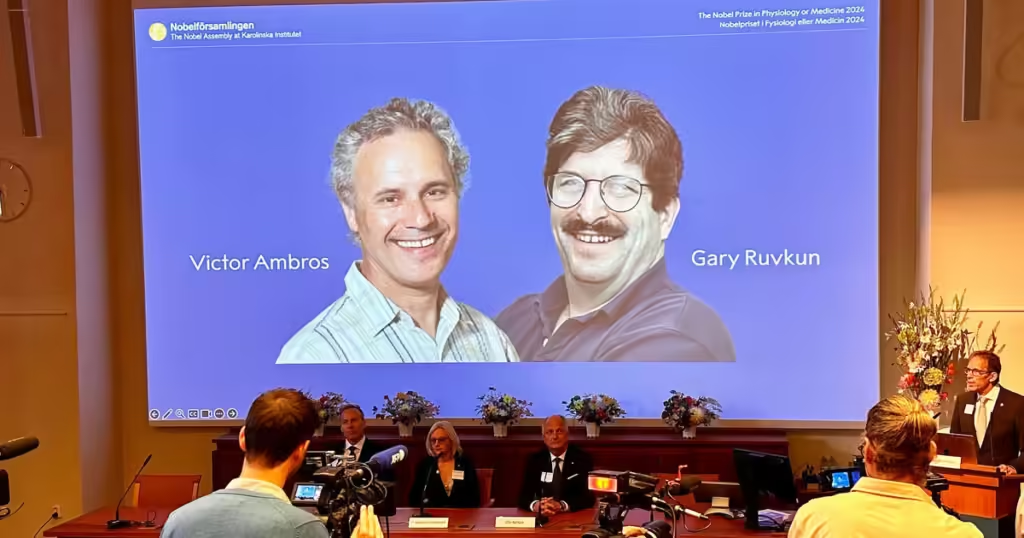When you think of the Nobel Prize microRNA, you might picture game-changing discoveries in physics or chemistry. But this year, microRNA—tiny molecules you’ve probably never heard of—just stole the spotlight. Why? Because these microscopic strands are revolutionizing how we understand genes, disease, and the future of medicine.
Let’s break it down.
What exactly is microRNA, and why should we care?
What Is microRNA?
Think of microRNA (miRNA) as tiny messengers that tell your body’s cells what to do. They’re short strands of RNA (ribonucleic acid) but don’t get bogged down by the science. In plain terms, microRNAs are like the “directors” of your genes. They guide which genes should be turned on or off, shaping how your cells behave.
What’s mind-blowing is that these microRNAs are only about 22 nucleotides long—that’s incredibly small! Yet, they control the expression of hundreds of genes.
Imagine a boss at a company managing hundreds of employees. If that boss makes the wrong decision, it can lead to chaos. That’s what happens in your body when microRNAs don’t do their job properly. And that’s why the Nobel Prize microRNA committee awarded the discovery of microRNAs.
Why Is microRNA a Big Deal?
Let me put it like this—microRNA has changed the game for understanding diseases like cancer, heart disease, and neurological disorders.
Before microRNAs were discovered, scientists thought RNA’s job was simple—transmit genetic information. But microRNA flipped that idea upside down. These tiny molecules were found to have a huge role in regulating genes. And when genes go haywire, diseases happen.
Cancer, for instance, can sometimes be traced back to misregulated microRNAs. That’s why researchers are excited about the potential for miRNA-based therapies, which could one day silence cancer-causing genes before they wreak havoc.
How Does microRNA Work?
In simple terms, microRNA is like a lock and key system. Each microRNA binds to a specific messenger RNA (mRNA), the molecule that carries genetic instructions. If a microRNA locks onto an mRNA, it prevents the instructions from being used.
No instructions, no action. The gene stays silent. This is a big deal in diseases where certain genes are overactive or mutated.
But enough with the technical talk—what does this mean for us?
How microRNA Could Change Medicine
Right now, most treatments focus on symptoms. Think about cancer treatments like chemotherapy—brutal on the body, killing both healthy and cancerous cells. MicroRNA-based therapies offer a more precise approach. Imagine a treatment that targets only the cancerous cells, leaving healthy ones untouched. This would mean fewer side effects, faster recovery, and more effective results.
Here’s how it could play out:
- Cancer therapies could silence genes that promote tumor growth.
- Cardiovascular treatments could help regulate genes causing heart disease.
- Neurological conditions like Alzheimer’s might be managed by adjusting the expression of brain-related genes.
Now that’s a future worth getting excited about.
Nobel Prize in Medicine 2024: The Discovery
This year’s Nobel Prize in Medicine was awarded for the discovery of microRNA. The laureates behind this groundbreaking work opened the door to new ways of thinking about genetics, disease, and therapeutic interventions. Their work started a medical revolution that could save millions of lives.
But why is this discovery making headlines now? The science isn’t exactly new—the key microRNA discoveries were made decades ago. But the applications in medicine have only recently started to explode. Researchers are now understanding how to harness microRNAs to develop targeted therapies that were once thought impossible.
The Scientists Behind the Discovery
The 2024 Nobel Prize was awarded to Gary Ruvkun, a pioneering figure in RNA research. Ruvkun’s work, alongside others, revealed how miRNA interacts with messenger RNA and how it regulates gene expression. This discovery has been a major turning point in biology.
Ruvkun’s findings laid the foundation for understanding diseases at a molecular level. We now know that miRNAs can cause or prevent diseases by regulating specific genes.
This discovery shifted the entire landscape of genetic research. It’s like finding out that your car has a hidden setting that drastically improves performance—only, instead of a car, we’re talking about the human body.
How Is This Relevant to You?
You might be wondering, “How does this impact me?”
Here’s the thing—gene therapy and microRNA treatments are no longer just ideas in a lab. They’re being developed right now. Clinical trials are already testing microRNA-based therapies for cancer and other diseases. It’s only a matter of time before these treatments become more widely available.
Imagine visiting your doctor in a few years and getting a personalized treatment based on your specific microRNA profile. Instead of one-size-fits-all solutions, medicine will be tailored to you. That’s a massive leap forward.
Real-world applications of microRNA
So how close are we to seeing microRNA therapies in hospitals? Closer than you think.
- Cancer Research: Scientists are developing microRNA-based drugs that target cancer cells without harming healthy ones. This could reduce the need for chemotherapy and radiation.
- Heart Disease: Research is exploring how microRNAs can regulate genes responsible for heart attacks and strokes. Treatments that tweak these microRNAs could lower the risk of future heart problems.
- Neurodegenerative Disorders: Studies are looking at how microRNAs can help manage diseases like Parkinson’s and Alzheimer’s by targeting specific brain-related genes.
FAQs
What is Nobel Prize microRNA?
MicroRNA (miRNA) is a small RNA molecule that regulates gene expression, controlling which genes are turned on or off.
Why is microRNA important in medicine?
It’s crucial because microRNA can influence the development of diseases like cancer, heart disease, and neurological conditions by regulating genes.
Who discovered microRNA?
The discovery was made by several scientists, including Gary Ruvkun, who won the Nobel Prize in 2024 for his contributions to RNA research.
How could microRNA impact cancer treatment?
MicroRNA-based therapies could target cancer cells specifically, reducing side effects and improving treatment outcomes.
What diseases could microRNA therapies help treat?
MicroRNA therapies have potential applications in cancer, heart disease, and neurodegenerative disorders like Alzheimer’s.
Wrapping It Up
The discovery of microRNA has completely changed how we think about genes and medicine. From cancer to heart disease, these tiny molecules could hold the key to personalized treatments that are more effective and less harmful.
As research continues, we’re getting closer to a future where doctors can treat diseases at the genetic level, providing more targeted and efficient therapies. The Nobel Prize in 2024 isn’t just a recognition of past work—it’s a sign that we’re on the brink of a new era in medicine.



